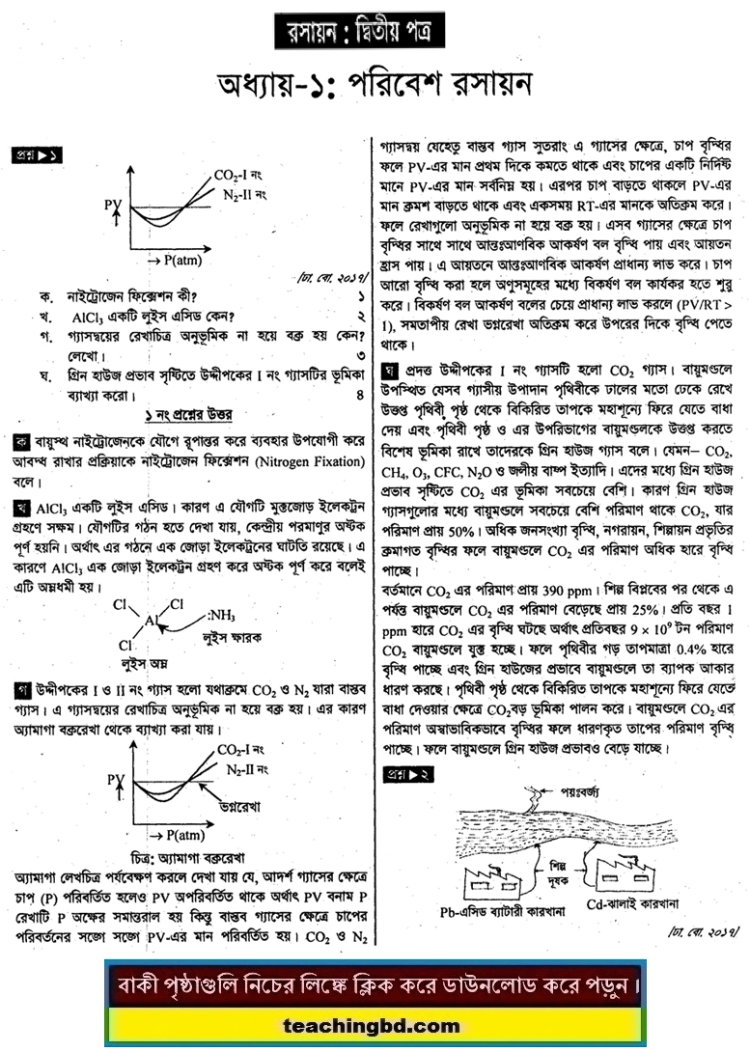HSC Chemistry 2nd Paper Note 1st Chapter Environmental Chemistry
HSC Chemistry 2nd Paper Note 1st Chapter Environmental Chemistry. Environmental chemistry is the scientific study of the chemical and biochemical phenomena that occur in natural places. It should not be confused with green chemistry, which seeks to reduce potential pollution at its source. It can be defined as the study of the sources, reactions, transport, effects, and fates of chemical species in the air, soil, and water environments; and the effect of human activity and biological activity on these. Environmental chemistry is an interdisciplinary science that includes atmospheric, aquatic and soil chemistry, as well as heavily relying on analytical chemistry and being related to environmental and other areas of science.
Environmental chemistry is the study of chemical processes occurring in the environment which are impacted by humankind’s activities. These impacts may be felt on a local scale, through the presence of urban air pollutants or toxic substances arising from a chemical waste site, or on a global scale, through depletion of stratospheric ozone or global warming. The focus in our courses and research activities is upon developing a fundamental understanding of the nature of these chemical processes so that humankind’s activities can be accurately evaluated.
Environmental chemistry involves first understanding of how the uncontaminated environment works, which chemicals in what concentrations are present naturally, and with what effects. Without this, it would be impossible to accurately study the effects humans have on the environment through the release of chemicals.
HSC Chemistry 2nd Paper Note 1st Chapter Environmental Chemistry


Quantitative chemical analysis is a key part of environmental chemistry since it provides data that frame most environmental studies. Common analytical techniques used for quantitative determinations in environmental chemistry include classical wet chemistry, such as gravimetric, titrimetric and electrochemical methods. More sophisticated approaches are used in the determination of trace metals and organic compounds. Metals are commonly measured by atomic spectroscopy and mass spectrometry: Atomic Absorption Spectrophotometry (AAS) and Inductively Coupled Plasma Atomic Emission (ICP-AES) or Inductively Coupled Plasma Mass Spectrometric (ICP-MS) techniques.
Organic compounds are commonly measured also using mass spectrometric methods, such as Gas chromatography-mass spectrometry (GC/MS) and Liquid chromatography-mass spectrometry (LC/MS). Tandem Mass spectrometry MS/MS and High Resolution/Accurate Mass spectrometry HR/AM offer subpart per trillion detection. Non-MS methods using GCs and LCs having universal or specific detectors are still staples in the arsenal of available analytical tools.
Other parameters often measured in environmental chemistry are radiochemicals. These are pollutants which emit radioactive materials, such as alpha and beta particles, posing danger to human health and the environment. Particle counters and Scintillation counters are most commonly used for these measurements. Bioassays and immunoassays are utilized for toxicity evaluations of chemical effects on various organisms. Polymerase Chain Reaction PCR is able to identify species of bacteria and other organisms through specific DNA and RNA gene isolation and amplification and are showing promise as a valuable technique for identifying environmental microbial contamination.
teachingbd24.com is such a website where you would get all kinds of necessary information regarding educational notes, suggestions and questions’ patterns of school, college, and madrasahs. Particularly you will get here special notes of physics that will be immensely useful to both students and teachers. The builder of the website is Mr. Md. Shah Jamal Who has been serving for 30 years as an Asst. Professor of BAF Shaheen College Dhaka. He expects that this website will meet up all the needs of Bengali version learners /students. He has requested both concerned students and teachers to spread this website home and abroad.


